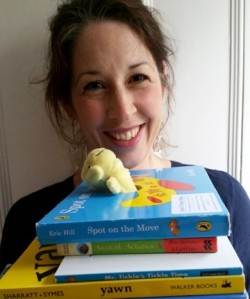Children's books and speech, language and communication needs
Published on: 31 July 2015 Author: Alex Strick
Rebecca Bryant is a specialist speech and language therapist with a passion for books. BookTrust's Alex Strick asks Rebecca about her work and how books can be made accessible and interesting to children with speech, language and communication needs.

How did your love affair with books start?
As a child, I grew up on Ladybird books. I was also obsessed by Roald Dahl and Quentin Blake, and loved The Twits. In fact my uncle and aunt bear such a resemblance to them they were known as Mr and Mrs Twit (but they are much kinder!)
I've always loved children's books; and as a parent and speech and language therapist I love finding new books for home and work!
Can you tell us about your work?
I work with children who have a range of speech, language and communication needs and additional needs or associated conditions such as cerebral palsy or autistic spectrum conditions. Some of the children use speech but others may use pointing, symbols, facial expression, Makaton signs or eye pointing to support or as an alternative to speech.
What do we need to know about Speech, language and communication needs?
The Communication Trust reports that speech, language and communication needs (SLCN) are one of the most common types of disability for children. Studies have shown that one in 10 children who have an SLCN will have this into adulthood. Another study suggests that in areas of deprivation more than 50 per cent of children will have SLCN.
However, SLCN can be a hidden disability with few outward signs. Some children may solely have a SLCN but many others have additional needs such as learning, sensory, or physical difficulties.
How do you engage children you work with?
The new Children's Laureate Chris Riddell and the amazing Shirley Hughes mentioned recently the importance of pictures in books as the way in to reading. In the Early Years and for children with SLCN and additional needs, picture books are also an important and widely available visual resource for assessing, supporting and developing speech, social communication, understanding and expressive language.
To make books more accessible and interesting for a child with SLCN, I choose books that are motivating and have a range of useful features. These could include the vocabulary, the clarity of the illustrations, limited and repetitive text or interactive features.
In addition to this I use props or multi-sensory resources for children to experience and use with the story to help understanding and expression. I may use a low-tech communication aid such as a 'talking tile', which has a picture or symbol on top and can 'speak' the recurring line in a book as a way of including children who may not be able to say or sign it.
The one thing I always use when using books is lots of facial expression, intonation, repetition, pointing, gestures, body language, acting and Makaton signing.
Makaton is a sign and symbol system that is used with speech for children and adults with SLCN. For more information visit www.makatoncharity.org
Can you tell us about your work with Brighton and Hove Librarie?s
It was thanks to the 'Talk to your Baby' conference that I ended up meeting with Norah Carr (Libraries Early Years' Services and Bookstart Co-ordinator for Brighton and Hove Libraries' Services).
I believe libraries have many important roles in our community and making books 'freely' available is just one of them. Brighton and Hove Libraries' Services run a variety of story and rhyme-time sessions. These led us to collaborate on some training recently to make the library environment and books more accessible. We wanted to make the library activities more accessible for children and adults with SLCN.
What sort of changes have the libraries made?
Nora's keenness for Makaton led the way to staff learning some Makaton signs and symbols that can be used in the library. It also enabled them to use some key animal signs to celebrate National Bookstart Week by signing this year's National Bookstart Week book, Rumble in the Jungle, and some other animal stories and songs such as Monkey and Me by Emily Gravett and the classic farming diversity song 'Old Mac Donald had a Zoo'!
The staff's enthusiasm to make the setting more 'communication friendly' and their knowledge of Makaton is already having a significant impact on supporting those with SLCN and means they are well on their way to becoming awarded 'Makaton Friendly' status.
What would you like to see happen next?
The 'Read on. Get on' campaign has helped highlight the high risk children with SLCN face when it comes to literacy difficulties. It also clearly states the need for early intervention and collaborative practice. So let's 'turn the page'! Let's use books to develop skills and make them more accessible and inclusive for children with SLCN and additional needs.
Topics: Bookmark, Disability, Interview, Features






Add a comment